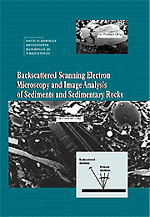6 - Carbonates
Published online by Cambridge University Press: 21 January 2010
Summary
INTRODUCTION
Carbonate rocks are generally less complex mineralogically than are siliciclastic sedimentary rocks. Ancient limestones are composed mainly of calcite, although some dolomite and aragonite (in very young rocks) may also be present. Low-magnesian calcite is the typical form of calcite; high-magnesian calcite (> 4 mol % MgCO3) is less common. Ancient dolomites (dolostones) are composed mainly of the mineral dolomite, with perhaps small amounts of lowmagnesian calcite. Other carbonate minerals such as magnesite, siderite, ankerite, and strontionite may be present in carbonate rocks in very minor amounts. The mineralogy of carbonate rocks is commonly studied by petrographic (light) microscopy, after etching and staining carbonate thin sections with an appropriate stain (e.g., Miller, 1988a). Carbonate minerals can be differentiated also by X-ray diffraction methods or, less commonly, by electron probe microanalysis (EPMA).
Texturally, limestones consist of various kinds of carbonate grains (clasts, fossils, ooids, peloids), microcrystalline calcite (lime mud or micrite), and sparry calcite cement. Identification of these textural elements is often of greater interest to geologists than is simple mineral identification. In addition to petrographic and X-ray diffraction analysis, the study of carbonate minerals has been greatly enhanced by use of cathodoluminescence (CL) techniques (e.g., Miller, 1989b; Barker and Kopp, 1991). CL petrography has proved to be especially useful in distinguishing among low-magnesian calcite, high-magnesian calcite, and dolomite, and in the study of zoning in dolomite crystals and carbonate cements.
Information
- Type
- Chapter
- Information
- Backscattered Scanning Electron Microscopy and Image Analysis of Sediments and Sedimentary Rocks , pp. 98 - 118Publisher: Cambridge University PressPrint publication year: 1998
